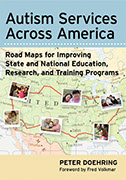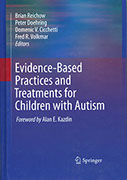Overall Program Growth
Even well-established comprehensive programs have struggled to adapt to the many changes in the awareness, identification, and education of persons with ASD over the past 15 years. During my 9-year tenure as Statewide Director of DAP, I sought to support the consolidation and growth of a program that was already a nationally-recognized program grounded in ABA.
Rapid changes in the awareness of ASD threatened to overwhelm the program because of the increased number of children and the broadening of the spectrum served. A program to ensure accurate identification of ASD helped to increase awareness about Asperger Syndrome and mitigate concerns about growth, and prompted analyses of overall growth patterns. Rapid growth also occurred in the number of staff, and placed pressure on our staff training programs.
Related Content
On this site
Key elements
Oversight
I provided oversight to the principle site of DAP (serving more than one-half of the student population) during much of my 9-year tenure as Statewide Director: I supervised more than 200 staff through 4 school administrators; I recruited and provided direct supervision for more than 25 psychologists and speech pathologists; I was the first point of contact for any concerns raised regarding students in the program across the state when these resulted in formal complaints or a recommendation for residential or private placement, and; I organized and conducted regular classroom visits. I also led another state committee providing general operational oversight, developing more rigorous and objective reviews, and implementing significant changes to state code and regulation.
New sites
I also led negotiations to develop collaborations with 3 new school districts, and to ensure that they were comparable in scope and quality. This growth allowed students to be educated in schools closer to their communities (in some cases, shaving two hours off of their total bus ride each day!). Together, these efforts helped DAP double in size and the number of community-based sites while maintaining program standards, and virtually eliminating the litigation that cripples many public school programs in the US. The growth also resulted in more than $8 million of major capital improvements at the three county centers.
Parent Involvement
The growth in the program and awareness of ASD also contributed to the increased involvement of parents. In addition to specific mechanisms of oversight for student safety and behavior support described elsewhere, another state committee providing general operational oversight utilizes rigorous and objective reviews. Parents in Delaware established an affiliated chapter of Autism Society of America (which has grown into an independent agency providing advocacy and services). A Statewide Parent Advisory Committee for DAP was re-established, as well as Parent Advisory Committees at each DAP site.
Statewide data collection and analysis
Together with members of the Autism and Developmental Disabilities Monitoring (ADDM) site funded through the Centers for Disease Control (CDC), I sought to facilitate data collection for students with Autism in Delaware. I also negotiated with state officials to obtain and to utilize state data on ASD enrollment for the analyses needed to project future growth, and conducted and presented analyses seeking to establish DAP’s success in serving the population of the state (Doehring and Winterling, 2011, 2013; Doehring, 2008).
Development of formal agreements
I led negotiations to develop formal written agreements between the State Department of Education and the school district hosting the Statewide Program, and to draft agreements between the Statewide Program and the host school districts outlining shared responsibility for services, training, funding, and oversight.
Infrequent due process or private placement
Throughout a nine year period when schools across the US were beset by legal actions that resulted in expensive settlements and placements, I helped DAP to maintained an unprecedented record of compliance and success. During my tenure, we faced only a handful of due processes which almost always resulted in a simple settlement, while maintaining extremely low rates of out-of-state placement (Doehring and Winterling, 2011, 2013).
 Creating right-sized satellite sites increases overall program capacity, improves access to community-based supports, and sets the stage for program replication
Creating right-sized satellite sites increases overall program capacity, improves access to community-based supports, and sets the stage for program replication
You cannot increase capacity without growing your overall program in some way. And you cannot increase participation in the community without accessing the community, and transporting people from specialized school programs to community settings can be incredibly complex and time consuming. Creating new community-based satellite sties can potentially address both issues.
At the same time, creating a community-based satellite site raises difficult questions: How many students would be housed? Where will they be housed? Are all students eligible? Who provides on-site supervision? In the end, through the experiences of expanding DAP, I was able to establish a list of considerations for determining the critical mass: the schedule and the intensity of instruction needed; the associated number of staff; the extent of the need for immediate supervision, and so on. I also learned that creating satellites increases the engagement of the host institution: staff are more likely to "get" the benefits of a more diverse student body for the entire student community, and can become more engaged in the kind of long-term planning needed for sustainability if not expansion.
 A public mandate to provide services fundamentally changes the nature and trajectory of a program's growth and impact
A public mandate to provide services fundamentally changes the nature and trajectory of a program's growth and impact
I was initially excited to lead a statewide public school program because of the potential to demonstrate the impact of scientific progress on a large scale. The public mandate to provide appropriate services created a challenges and opportunities which I did not anticipate, and which programs without a public mandate need never address.
We do not turn students away: I had to ensure that the program kept pace with the dramatic increase in the student population. This challenge fundamentally re-oriented my strategies and my resources: for example, I became focused on issues surrounding long-term capacity building, like how to develop the skills of new staff members, how to replicate sites in new school districts, and so on. As a public school program, we were never "full".
We provide services immediately: The public mandate to provide appropriate services also created an incentive to ensure that our program was immediately responsive to the needs of all children with ASD, regardless of their characteristics: (a) we could not maintain a waiting list: we had to ensure that every student possibly in need of our programs was rapidly assessed, and then immediately placed in one of our classrooms if that was the IEP team's recommendation, and; (b) we also could not simply refuse to provide services because of co-occurring intellectual disabilities or challenging behavioral or mental health conditions.
We serve all families: The public mandate to provide appropriate services also created an incentive to ensure that our program was responsive and accessible to the needs of all families, regardless of their backgrounds. We could not be intentionally or unintentionally selective (i.e., through fees charged to families). This led us to adapt our services and reach out to traditionally under-served groups.
We are accountable to the public: With the public mandate came public accountability. We could not simply raise fees, but had to live within the budgets we could negotiate with the school districts and the state. We were accountable to families we served, and this led us to be much more transparent and proactive in seeking and responding to the input from parent advocate groups.
Current vita
My Presentations and Publications
 With Vince Wintering, (2013). Delaware Autism Program: Statewide Educational Services in the Public Schools. In Autism Services Across America: Roadmaps for Improving State and National Education, Research, and Training Programs. Paul H. Brookes Publishing Co., Baltimore, MD.
With Vince Wintering, (2013). Delaware Autism Program: Statewide Educational Services in the Public Schools. In Autism Services Across America: Roadmaps for Improving State and National Education, Research, and Training Programs. Paul H. Brookes Publishing Co., Baltimore, MD.
 With Vince Wintering. (2011). The Implementation of Evidence-Based Practices in the Public Schools. In Evidence-Based Practices and Treatments for Children with Autism. (2011). Springer-Verlaug, New York, NY.
With Vince Wintering. (2011). The Implementation of Evidence-Based Practices in the Public Schools. In Evidence-Based Practices and Treatments for Children with Autism. (2011). Springer-Verlaug, New York, NY.
 (2008). A model for regional training and service delivery for children with autism. International Society for Autism Research. London, UK.
(2008). A model for regional training and service delivery for children with autism. International Society for Autism Research. London, UK.
 (2007). The Delaware Autism Program. Autism Policy: Current Trends and Visions for the Future. Invited talk. Pennsylvania Department of Public Welfare, Philadelphia, PA.
(2007). The Delaware Autism Program. Autism Policy: Current Trends and Visions for the Future. Invited talk. Pennsylvania Department of Public Welfare, Philadelphia, PA.
 With Ed Bosso, & Peggy Lashbrook.(2005). Models of regional networks of excellence for low incidence disabilities. Association for Curriculum and Supervision Development, Orlando. FL
With Ed Bosso, & Peggy Lashbrook.(2005). Models of regional networks of excellence for low incidence disabilities. Association for Curriculum and Supervision Development, Orlando. FL
![]() (2003) Providing comprehensive services for students with autism in a public school. Invited talk. Autism-Europe, Rome, Italy.
(2003) Providing comprehensive services for students with autism in a public school. Invited talk. Autism-Europe, Rome, Italy.
X